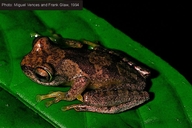|
Description
A small brown treefrog, M SVL 24-27 mm. Tibiotarsal articulation reaches the nostril or between nostril and snout tip. Hand with some webbing, foot webbing 1(0), 2i(1), 2e(0), 3i(1), 3e(0.5), 4i/e(1.25), 5(0.25). Dorsal skin smooth. Colouration very variable. Can be uniformly light brown, or brown with a large dark hourglass marking, or brown with lichen-like yellow or pink spots. Ventrally white. No red colour on limbs or on iris.
The tibia is clearly longer than the foot. Vomerine teeth are present. A nuptial pad is recognizable on the irst finger. Males with a single subgular vocal sac. Bones are distinctly green.
In life some rather indistinct dark crossbands are present on the legs. The tips of fingers and toes are greenish. The belly is centrally silvery white and laterally transparent. The throat is transparent with a green shade. In preservative the colouration of the back has not changed substantially. The ventral side is yellowish white. Iris is light brown to grey, with some reddish-brown colour. Iris periphery greenish yellow.
Similar species: Morphologically very similar to B. marojezensis, but the calls of both species are very different. Variation: The population observed in the Manarikoba forest at the Tsaratanana Massif is similar to that from the type locality Montagne d’Ambre, but is genetically strongly differentiated, indicating possible taxonomic distinctness.
Variation: The population observed in the Manarikoba forest at the Tsaratanana Massif is similar to that from the type locality Montagne d’Ambre, but is genetically strongly differentiated, indicating possible taxonomic distinctness. Distribution and Habitat
Country distribution from AmphibiaWeb's database: Madagascar
Montagne d’Ambre, Tsaratanana (Andampy campsite). Elevation range (800-1200m asl). This species inhabits humid rainforest, living only in slightly modified habitats. Breeding occurs in streams (Nussbaum et al. 2008).
Life History, Abundance, Activity, and Special Behaviors
Males call at night along streams in rainforest, from perches 0.5-2 m high in the vegetation. Males were found calling in March in primary forest. They were heard after sunset mainly along noisy brooks from vegetation about 0.5-1.5 m above the ground.
Call (from the terra typica): A very irregular series of high-pitched chirps and trills, reminding calls of small birds. Consists of two different note types. Note type 1 is an unharmonious pulsed sound (5-6 pulses recognizable) with a duration of 210-280 ms. Note type
2 is a short click of 55-85 ms. These notes are arranged in series, typically
3 notes of type 1 followed by 2-4 notes of type 2. Intervals between the notes
are 300-650 ms and tend to increase towards the end of the call. Frequency of
both note types is between 3.8 and 5.9 kHz.
Eggs and tadpoles:
Unknown.
Trends and Threats
Vulnerable: extent of occurrence is less than 20,000 km2, it is known from fewer than ten locations, and there is continuing decline in the extent and quality of its habitat in northern Madagascar. It occurs in Parc National de Montagne d'Ambre and Réserve Naturelle Intégrale du Tsaratanana (Nussbaum et al. 2008).
Possible reasons for amphibian decline General habitat alteration and loss
Habitat modification from deforestation, or logging related activities
Intensified agriculture or grazing
Urbanization
Habitat fragmentation
Comments
Derivatio nominis:
Dedicated to Rose Blommers-Schlösser, Rhenen, in recognition of her invaluable
contributions to the knowledge of Malagasy frogs.
Taken with permission from Glaw and Vences (2007).
References
Glaw, F. and Vences, M. (1994). Amphibians and Reptiles of Madagascar. M. Vences and F. Glaw Verlags GbR., Köln.
Glaw, F., and Vences, M. (2007). Field Guide to the Amphibians and Reptiles of Madagascar. Third Edition. Vences and Glaw Verlag, Köln.
Nussbaum, R., Raxworthy, C., and Glaw, F. (2008). Boophis blommersae. In: IUCN 2008. 2008 IUCN Red List of Threatened Species. www.iucnredlist.org. Downloaded on 08 April 2009.
Originally submitted by: Miguel Vences and Frank Glaw (first posted 2000-10-24)
Edited by: Henry Zhu (2009-05-05)Species Account Citation: AmphibiaWeb 2009 Boophis blommersae <https://amphibiaweb.org/species/4333> University of California, Berkeley, CA, USA. Accessed May 24, 2025.
Feedback or comments about this page.
Citation: AmphibiaWeb. 2025. <https://amphibiaweb.org> University of California, Berkeley, CA, USA. Accessed 24 May 2025.
AmphibiaWeb's policy on data use.
| 